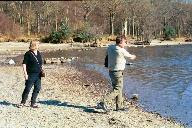Boxing Day., and dawns brightly over the orange grove. Flowering trees sparkling as well. Breakfast buffet fine, if interestingly arranged, e.g. queue slowed by the fact that cups and spoons are on one side of the hot water urn - tea bags and coffee powder on the other. Lovely sunny room.
After breakfast we drive out to Belapais, perched on the edge of the mountains looking down at Kyrenia. It's probably only 5 km or so from Kyrenia, but uphill most of the way. We've all walked it in the past and taking the car makes it zoom by. The centre of the village is a restaurant and shop next to the "tree of idleness" made famous by Lawrence Durrell in Bitter Lemons of Cyprus as the sleepy spot where men used to sit and play backgammon and drink coffee - not, in those days Nescafé. Sadly, the restaurant has surrounded the tree so that it's no longer possible to sit under it.
Long before Durrell, Belapais was home to an abbey founded by the Augustinian monks who had been forced to leave Jerusalem when it was conquered by Saladdin. It's a ruin now, but a pretty impressive one, and in the days before spreading villas and suburbs it would have looked down over fruit trees and olive trees and wandering goats to the deep blue Mediterranean, the mountains of Turkey on the other side just visible as they merge with the clouds.
We set out to explore the abbey, starting with the church. There's some elaborate carving in the large Gothic space, and big chandeliers. The man in charge shows us an amazingly complex pulpit carved out of a single piece of hardwood. Interestingly, the decline of the abbey began not with the Turkish occupation, but after the Ottomans gave it to the Orthodox in 1570. Its moral decline began somewhat earlier, though. The Augustinians gave way almost immediately to the Norbertines in the early 13th century, and by the mid sixteenth centry monks had one, or even two, wives and were accepting only their own children as novices. In its glory days, though, it was rich and influential, at times the residence, and then burial place, of kings. The refectory is the best preserved part, 30 metres by 10 metres, with a ceiling much higher than its width. A rose window is at the peak in the eastern end, and on the north side windows overlook the Mediterranean, darkly blue in the distance beneath. A pulpit at one side would have been used by a monk reading to the others during meal times. The hall is now full of folding chairs, as the space is used on occasion for concerts.
It's warm in the sun after the stone chill, and we stop to enjoy coffee at the café in the grounds against this incredible background of aabbey ruins and sea.
Drive through the hills on the side of the mountains with more wonderful views. Then down along the coast, where we stop for lunch at a restaurant across from a beach where turtles come to lay their eggs. We only really want a sandwich, with dinner in the offing, and it's fine. But for me the truly impressive thing here is the toilet seat. Jane informs me that it's not unique, but I've never seen one like it. Before use, you press a button and the seat, which appears to be covered with something like cling wrap, rotates, providing a new and presumably pristine surface. Can't imagine how it works - hygienically that is, not mechanically. Disinfectant? Heat treatment? Little pixies in the back armed with new cling wrap?
Back at the Ship Inn, dinner comes almost too soon. J and I both order the fahita makings that Jane had Christmas Eve - and it is as nice as it looks, especially as Joe asks for and is delighted to receive what we only know as beber. That's the Turkish word for pepper, but what they have - only in North Cyprus and Turkey as far as we can see - is a softly flaked red pepper, medium hot.









